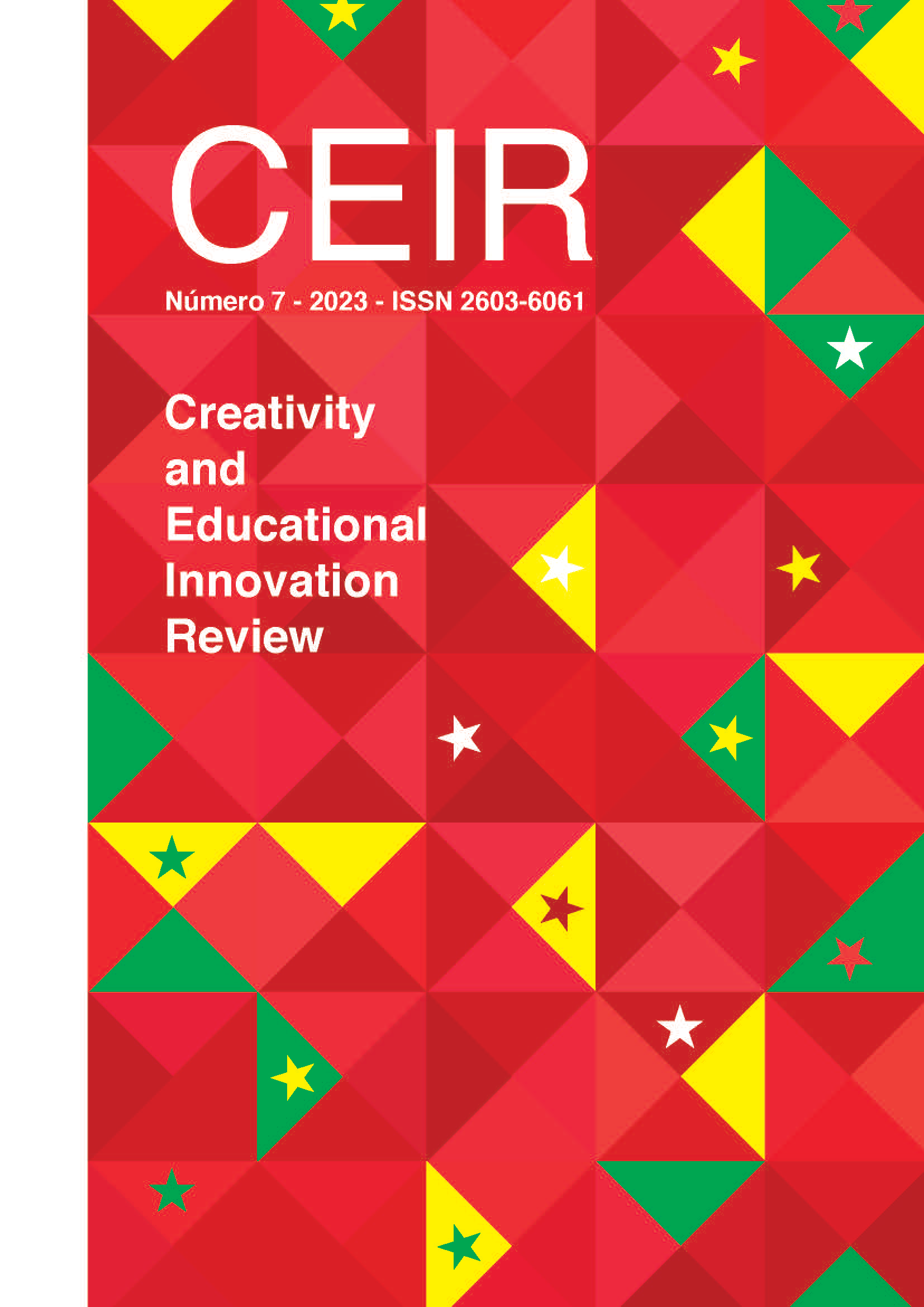Implicaciones del conflicto bélico ruso-ucraniano en el alumnado de Educación Infantil refugiado en la Comunidad Valenciana. Estudio de casos
DOI :
https://doi.org/10.7203/CREATIVITY.7.27322Mots-clés :
desarrollo emocional, educación infantil, conflicto bélico Ucrania, educación inclusiva. Résumé
Résumé
El artículo explora i diagnostica los efectos de los conflcitos bélicos en los contextos socioeducativos.
 Téléchargements
Téléchargements
 Références
Références
ACNUR. (24 febrero de 2023). Guerra en Ucrania: un año viviendo bajo las bombas. https://eacnur.org/es/actualidad/noticias/emergencias/guerra-en-ucrania-un-ano-viviendo-bajo-las-bombas.
Ajdukovic, M. y Ajdukovic, D. (1998). Impact of displacement on psychological well-being of refugee children. International Review of Psychiatry,10, 186–195.
Allwood, M.A., Bell-Dolan, D., y Husain, S.A. (2002). Children’s trauma and adjustment reactions to violent and nonviolent war experiences. Journal of the American Academy of Child and Adolescent Psychiatry, 41, 450–457.
Attanayake, V., McKay, R., Jeffres, M., Singh, S., Burkle, F., Jr., y Mills, E. (2009). Prevalence of mental disorders among children exposed to war: A systematic review of 7,920 children. Medicine, Conflict and Survival, 25, 4–19.
Barenbaum, J., Ruchkin, V., y Schwab-Stone, M. C. (2004). The psychosocial aspects of children exposed to war: Practice and policy initiatives. Journal of Child Psychology and Psychiatry, 45, 41–62.
Betancourt, T. S. (2011). Attending to the mental health of war-affected children: The need for longitudinal and developmental perspectives. Journal of the American Academy of Child & Adolescent Psychiatry, 50, 323– 325.
Betancourt, T. S., y Khan, K. T. (2008). The mental health of children affected by armed conflict: Protective processes and pathways to resilience. International Review of Psychiatry, 20, 317–328.
Bronfenbrenner, U. (1979). The ecology of Human Development. Cambridge, Harvard University Press.
Bronfenbrenner, U., y Morris, P. A. (2007). The bioecological model of human development. Handbook of child psychology, 1.
Chandra, A., Lara-Cinisomo, S., Jaycox, L., Tanielian, T., Burns, R. M., Ruder, T., et ál. (2010). Children on the homefront: The experience of children from military families. Pediatrics, 125, 16–25.
Chase, R., Doney, A., Sivayogan, S., Ariyaratne, V., Satkunanayagam, P., y Swaminathan, A. (1999). Mental health initiatives as peace initiatives in SriLankan schoolchildren affected by armed conflict. Medicine, Conflict, and Survival,15, 379–390.
Cohen, J.A., Mannarino, A.P., y Rogal, S. (2001). Treatment practices for childhood posttraumaticstress disorder. Child Abuse and Neglect, 25, 123–135.
Dybdahl, R. (2001a). A psychosocial support programme for children and mothers in war. Clinical Child Psychology and Psychiatry, 6, 425–436.
Hodes, M., Jagdev, D., Chandra, N., y Cunniff, A. (2008). Risk and resilience for psychological distress amongst unaccompanied asylum seeking adolescents. Journal of Child Psychology and Psychiatry, 49(7), 723-732. DOI: 10.1111/j.1469-7610.2008.01912.x
Kuterovac-Jagodic´, G. (2003). Posttraumatic stress symptoms in Croatian children exposed to war. Journal of Clinical Psychology, 59, 9–25.
López Cassà, È. (2005). La educación emocional en la educación infantil. Revista interuniversitaria de Formación del Profesorado, 19(3), 153-167.
López, N. (2022). Consecuencias del conflicto bélico en el cerebro infantil. PSYCOLab. https://www.psycolab.com/consecuencias-del-conflicto-belico-en-el-cerebro-infantil/.
Luthar, S. S. (1993). Annotation: Methodological and conceptual issues in research on childhood resilience. Journal of child psychology and psychiatry, and allied disciplines, 34(4), 441.
Martínez, M.D., Ucros, M., y Vanegas, B.X. (2016). Impacto de experiencias traumáticas sobre el desarrollo cognitivo, emocional y familiar en niños y adolescentes víctimas de violencia. Revista Tesis Psicológica, 11(1), 206-215.
Masten, A. S., y Narayan, A. J. (2012). Child development in the context of disaster, war, and terrorism: Pathways of risk and resilience. Annual Review of Psychology, 63, 1–31.
Piñeros-Ortiz, S., Moreno-Chaparro, J., Garzón-Orjuela, N., Urrego-Mendoza, Z., Samacá-Samacá, D., y Eslava-Schmalbach, J. (2021). Consecuencias de los conflictos armados en la salud mental de niños y adolescentes: revisión de revisiones de la literatura. Biomédica, 41(3), 424-448.
Porterfield, K., Akinsulure-Smith, A. M., Benson, M. A., Betancourt, T., Heidi Ellis, B., Kia-Keating, M., y Miller, K. (2010). Resilience & recovery after war: Refugee children and families in the United States.
Rutter, M. (1985). Resilience in the face of adversity: Protective factors and resistance to psychiatric disorder. The British Journal of Psychiatry, 147, 598–611. https://doi.org/10.1192/bjp.147.6.598.
Sack, W. H., Him, C., y Dickson, D. (1999). Twelve-year follow-up study of Khmer youths who suffered massive war trauma as children. Journal of the American Academy of Child & Adolescent Psychiatry, 38, 1173–1179.
Sadeh, A., Hel-Gal, S., y Tikotzky, L. (2008). Reacciones de los niños al estrés relacionado con la guerra: encuesta y valoración de una intervención innovadora. Pediatrics, 65(1), 11-18.
Strauss, K., Dapp, U., Anders, J., von Rentel-Kruse, W., y Schmidt, S., (2011). Range and specificity of war-related trauma to posttraumatic stress, depression and general health perception: Displaced former World War II children in later life. Journal of Affective Disorders, 128, 267–276.
Werner, E. E. (2012). Children and war: Risk, resilience, and recovery. Development and psychopathology, 24(2), 553-558.
Téléchargements
Publié-e
Comment citer
-
Résumé169
-
PDF (Español)142
Numéro
Rubrique
Licence

Este obra está bajo una licencia de Creative Commons Reconocimiento-NoComercial-SinObraDerivada 4.0 Internacional.



